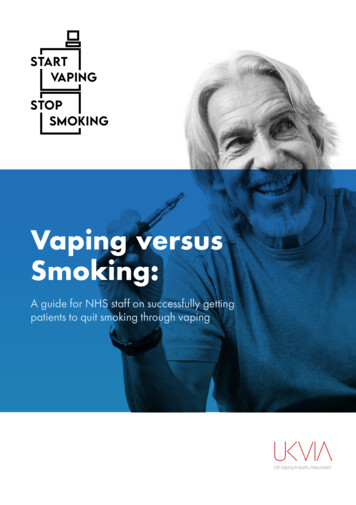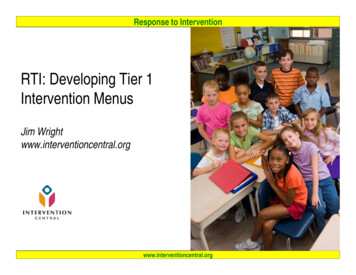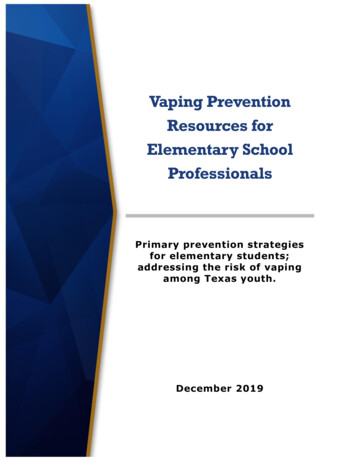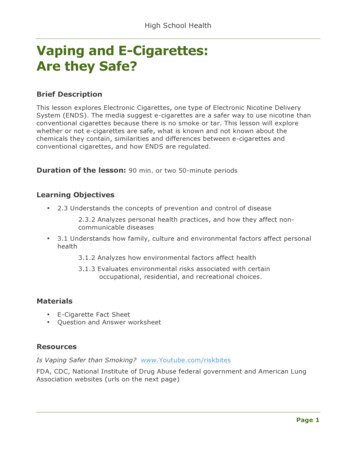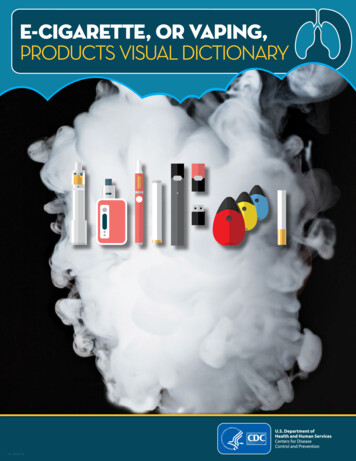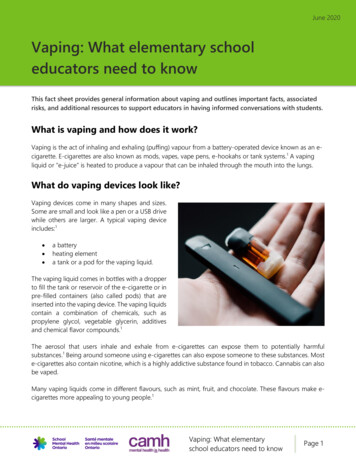
Transcription
June 2020Vaping: What elementary schooleducators need to knowThis fact sheet provides general information about vaping and outlines important facts, associatedrisks, and additional resources to support educators in having informed conversations with students.What is vaping and how does it work?Vaping is the act of inhaling and exhaling (puffing) vapour from a battery-operated device known as an ecigarette. E-cigarettes are also known as mods, vapes, vape pens, e-hookahs or tank systems.1 A vapingliquid or “e-juice” is heated to produce a vapour that can be inhaled through the mouth into the lungs.What do vaping devices look like?Vaping devices come in many shapes and sizes.Some are small and look like a pen or a USB drivewhile others are larger. A typical vaping deviceincludes:1 a batteryheating elementa tank or a pod for the vaping liquid.The vaping liquid comes in bottles with a dropperto fill the tank or reservoir of the e-cigarette or inpre-filled containers (also called pods) that areinserted into the vaping device. The vaping liquidscontain a combination of chemicals, such aspropylene glycol, vegetable glycerin, additivesand chemical flavor compounds.1The aerosol that users inhale and exhale from e-cigarettes can expose them to potentially harmfulsubstances.1 Being around someone using e-cigarettes can also expose someone to these substances. Moste-cigarettes also contain nicotine, which is a highly addictive substance found in tobacco. Cannabis can alsobe vaped.Many vaping liquids come in different flavours, such as mint, fruit, and chocolate. These flavours make ecigarettes more appealing to young people.1Vaping: What elementaryschool educators need to knowPage 1
What are the health risks of vaping?Because vaping is still relatively new, researchers are still learning about its long-term health effects. Theshort-term effects include:1 mouth or throat irritation shortness of breath cough nausea.Vaping is not without risk and can increase exposure to chemicals that may cause health harms, includinglung damage.2 This may make students who vape more susceptible to COVID-19.3E-cigarettes can also increase the spread of disease since they are also often shared between students.4 Itshould be conveyed to students that if they choose to vape, they should avoid sharing their devices(including electronic hookah/shisha pipes and cannabis products) with other students to avoid spreadingillness.Vaping products with nicotine and/or cannabis during adolescence can also: affect the brain, which continues to develop until approximately age 25 1cause addiction and dependence, leading to prolonged use or transition to tobacco cigarettes andassociated negative health impacts 1,5 impact learning, memory, concentration and attention 1,2 worsen symptoms of depression and anxiety 1 reduce impulse control 2 cause behavioural problems.2Nicotine toxicity can happen due to swallowing or breathing in the vaping liquid or absorption through theskin or eyes of large amounts of nicotine.1,6 This can cause dizziness, headaches, vomiting, nausea,increased heart rate and death.1 Young children and pets are at a greater risk.If you think a student has been exposed to toxic amounts of nicotine, call Ontario Poison Centre at 1-800268-9017 for advice on what symptoms to look out for and whether medical attention is needed.Vaping: What elementaryschool educators need to knowPage 2
What are the laws around vaping?Provincial and federal laws work together to protect children and youth. It is against the law to sell orsupply tobacco and vapour products to anyone under the age of 19. The Smoke-Free Ontario Act, 2017prohibits the use of e-cigarettes (inhaling, exhaling, or holding an activated e-cigarette) to vape anysubstance in enclosed public places, enclosed workplaces and certain other places, such as the followingplaces, among others: public and private schools school grounds and all public areas within 20 metres of these grounds children’s playgrounds and all public areas within 20 metres of playgrounds grounds of community recreational facilities and all public areas within 20 metres of thesegrounds publicly-owned sporting areas (not including golf courses), nearby spectator areas and publicareas within 20 metres of these areas.7Additional restrictions on smoking and vaping may exist in municipal bylaws, and the policies ofemployers and property owners.Here are some important sources for additional information on laws around vaping: Where you can’t smoke or vape in Ontario tario Rules for selling tobacco and vapour products in Ontario nd-vapour-products Federal Tobacco and Vaping Products Act cco-act.html Federal Vaping Product Regulations How can I promote student well-being and prevent harms relatedto vaping?Here are some approaches to use when educating students about vaping:Avoid criticism and encourage open dialogue by approaching the topic of vaping in aknowledgeable, supportive, and non-judgmental way. Help students to really understand thatvaping carries health and cognitive risks, particularly for people under age 25 because theirbrains are still developing.Vaping: What elementaryschool educators need to knowPage 3
Provide students with opportunities to learn about vaping. Discuss the risks and costs (physical,psychological and financial) associated with vaping. The topic can be a part of regularinstruction (e.g., health and physical education, financial literacy, media literacy in language).Understand that some young people may vape in response to stress and difficult feelings. Helpstudents explore ways to manage stress and feelings without vaping. Strategies, such as talkingto a trusted adult (e.g., a parent/guardian, teacher, school staff member) and accessingcommunity resources that can help students find healthy ways to deal with stress, understandthe risks associated with vaping, make informed decisions, and to manage peer pressure.Support students in exploring the choices they have if others pressure them to use e-cigarettes.Feeling social pressure from friends or others to use e-cigarettes can be challenging, but it isimportant for students to know that most students do not vape.1Have students critically examine the marketing tactics that the vape industry uses to enticeyouth, such as using trendy packaging, social media influencers, celebrity endorsements andfruity flavours.1 These learning opportunities help students understand that the vape industryuses advertising strategies to make vaping look appealing, while not necessarily sharing thehealth risks of vaping.Collaborate with public health partners to apply the Healthy Schools approach in order tointegrate health promotion activities across the whole school and support communitymessaging to parents and guardians. For more information on Healthy Schools, ions.html.What are some facts about vaping?Fact 1: Vaping behaviours are different across grade groups.It is important to recognize grades and groups that may be at higher risk when educating students aboutvaping. Tailoring information to students’ age, while sharing appropriate resources with students who are ata higher risk of vaping, can help these students make informed choices. A 2019 survey found that:4 23% of Ontario students in Grades 7–12 had used e-cigarettes in the previous year.While students in Grades 7 and 8 were less likely to use e-cigarettes than high school students,students in Grade 8 were more than 2.5 times as likely (5%) to have tried an e-cigarette comparedto those in Grade 7 (2%).Male and female students in grade 7–12 are equally as likely to use e-cigarettes.4The 2019 report does not include data on non-binary students. Research is needed on vaping use forstudents who are non-binary.Vaping: What elementaryschool educators need to knowPage 4
Fact 2: Vaping is NOT harmless.There are no long-term studies on vaping, so long-term health effects are still unknown.1 Provide yourstudents with the opportunity to learn about the health effects of vaping to make healthy, informed choices,such as avoiding nicotine and tobacco products entirely to protect their health.Fact 3: E-cigarettes are NOT a proven effective quit smoking aid for youth.Although some studies have shown that vaping can be an effective quit smoking tool for adults, this has notbeen proven for youth. In fact, research shows that there’s a greater risk it will lead youth to start smokingtobacco cigarettes.1,8If a student tells you they are interested in quitting smoking, provide information about resources such asKids Help Phone, which can provide non-judgmental and confidential support over the phone at 1-800-6686868. Students can also text CONNECT to 686868 or visit the website at www.kidshelpphone.ca.You can also direct students to a free Quit Coach for non-judgmental and confidential support over thephone by calling Telehealth Ontario at 1-866-797-0000 or toll-free TTY at 1-866-797-0007. Students mayalso access digital smoking cessation services from the Canadian Cancer Society’s Smokers’ Helpline byvisiting www.smokershelpline.ca or texting iQuit to 123456.Fact 4: Vaping is linked to mental health and substance use problems.Although this is a growing area of research and relatively little is known about the specific associationsbetween e-cigarettes and mental health, current evidence shows a relationship between vaping and mentalhealth and substance use problems.9 However, the direction of the relationship (does vaping lead to theseissues or do these issues lead to vaping) is not known.How does vaping connect to the curriculum?Ontario's 2019 Elementary Health and Physical Education Curriculum provides diverse opportunities forstudents to learn about vaping to make healthier choices for their overall well-being.Learning related to vaping occurs in Grade 4 and 6 with additional references starting in Grade 1. Inelementary school, students learn to make informed decisions about their health in order to encourage themto lead healthy lives. This includes learning about adopting and maintaining healthy behaviours, as well aslearning about the risks of vaping and its health effects. Student also learn about various factors that affectdecisions about vaping, and how to apply decision making, assertiveness, and refusal skills to manage socialpressures and make healthy informed choices. Below are learning expectations within the elementary Healthand Physical Education curriculum that support learning about vaping.Vaping: What elementaryschool educators need to knowPage 5
GRADE 1Substance Use, Addictions, and Related Behaviours (D3.2) Students “identify habits and behaviours (e.g., excessive screen time or video game usage, smoking,vaping) that can be detrimental to health, and explain how people can be encouraged to adopthealthier alternatives”GRADE 4Substance Use, Addictions, and Related Behaviours (D1.4, D2.3, D3.2) Students “identify substances (e.g., nicotine, carbon monoxide, tar) found in tobacco and vapingproducts, and describe their effects on health”. Students “demonstrate the ability to make and support healthy, informed choices about smokingand vaping, using their understanding of factors that affect decisions about smoking and vaping anda variety of social-emotional learning skills (e.g., applying decision-making, assertiveness, and refusalskills; considering alternative coping strategies for stressful situations; thinking in advance aboutvalues, cultural beliefs, and personal choices; identifying the pros and cons of both making a changeand not making a change; being aware of peer pressure; avoiding situations where people will besmoking or vaping; using conversational strategies, such as saying no strongly and clearly, givingreasons, changing the topic, making a joke, asking a question)”. Students “describe the short- and long-term effects of first- and second-hand smoke on smokersand on people around them, and the effects of vaping”.Mental Health Literacy (D2.5) Students “demonstrate an understanding of how choices they make every day can have a positiveimpact on their mental health”.GRADE 5Substance Use, Addictions, and Related Behaviours (D2.3) Students “demonstrate the ability to apply decision-making, assertiveness, and refusal skills to dealwith pressures pertaining to alcohol use or other behaviours that could later lead to addiction (e.g.,smoking, vaping, drug use, gambling, video game use)”.GRADE 6Substance Use, Addictions, and Related Behaviours (D2.4) Students “use decision-making strategies and skills and an understanding of factors influencing druguse (e.g., personal values, peer pressure, media influence, curiosity, legal restrictions, cultural,religious, and spiritual teachings) to make safe personal choices about the use of drugs such asalcohol, tobacco, and cannabis, and about activities such as vaping, including the choice to abstain”.Vaping: What elementaryschool educators need to knowPage 6
GRADE 7Substance Use, Addictions, and Related Behaviours (D3.2) Students “analyse the personal and societal implications of issues related to substance use,addictions, and related behaviours (e.g., risks associated with vaping and chewing tobacco; effectsof second-hand smoke on non-smokers and children; legal and health implications of underagedrinking and cannabis use)”.Where can I get more information?About vaping oking-tobacco/vaping.htmlYouth vaping prevention materials ng to teens about vaping rents.htmlPublic health units US Department of Health and Human Services. (2016). E-cigarette Use Among Youth and Young Adults: A Report of theSurgeon General. Available: https://www.cdc.gov/tobacco/data statistics/sgr/ecigarettes/pdfs/2016 sgr entire report 508.pdf. Accessed April 24, 2020.Health Canada. Risks of vaping. Government of Canada. Available: king-tobacco/vaping/risks.html. Accessed May 22, 2020.Canadian Paediatric Society. (2020). COVID, Youth, and Substance Use: Critical Messages for Youth and Families. h-and-families. AccessedApril 24, 2020.Boak, A., Elton-Marshall, T., Mann, R.E. & Hamilton, H.A. (2020). Drug Use Among Ontario Students, 1977–2019: DetailedFindings From the Ontario Student Drug Use and Health Survey (OSDUHS). Toronto, ON: Centre for Addiction and MentalHealth. Available: gusereport 2019osduhspdf.pdf?la en&hash 7F149240451E7421C3991121AEAD630F21B13784 . April 24, 2020.Hammond, D., Reid J.L., Cole, A.G. & Leatherdale, S.T. (2017). Electronic cigarette use and smoking initiation among youth:A longitudinal cohort study. CMAJ, 189 (43), E1328–36. Available: https://doi.org/10.1503/cmaj.161002. Accessed April 24,2020.Centers for Disease Control and Prevention (CDC). New CDC study finds dramatic increase in e-cigarette-related calls topoison centers. CDC Newsroom. Available: garette-poison.html.Accessed April 24, 2020.Government of Ontario. (2017). Smoke-Free Ontario Act, 2017. Available: sed April 24, 2020.Soneji, S., Barrington-Trimis, J.L., Wills, T.A., Leventhal, A.M., Unger, J.B., Gibson, L.A. et al. (2017). Association betweeninitial use of e-cigarettes and subsequent cigarette smoking among adolescents and young adults: A systematic reviewand meta-analysis. JAMA Pediatrics, 171 (8), 788–797. Available: sed May 13, 2020.Grant, J.E., Lust, K., Fridberg, D.J., King, A.C. & Chamberlain, S.R. (2019). E-cigarette use (vaping) is associated with illicitdrug use, mental health problems, and impulsivity in university students. Annals of Clinical Psychiatry: Official Journal of theAmerican Academy of Clinical Psychiatrists, 31 (1), 27–35.Vaping: What elementaryschool educators need to knowPage 7
Page 5 Vaping: What elementary school educators need to know Fact 2: Vaping is NOT harmless. There are no long-term studies on vaping, so long-term health effects are still unknown.1 Provide your students with the opportunity to learn about the health effects of vaping to make healthy, informed choices,

